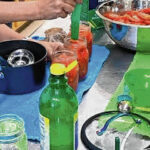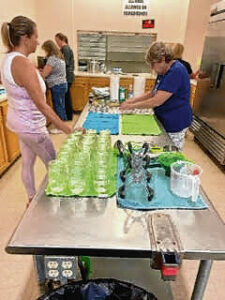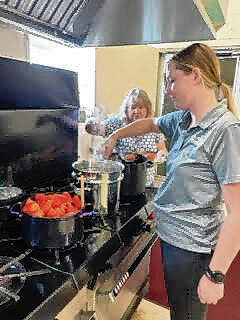Editor’s note: The Daily Reporter regularly features agricultural and health information for the community, partnering with Hancock County Purdue Extension. Since a class on food preservation earlier this month filled up so quickly, Mandy Gray provides tips and insight on canning produce in this question-and-answer feature. Gray is a Purdue educator specializing in health and human science. She’s worked with Purdue for 10 years, previously in the nutrition education program and has been trained in food preservation. Gray is part of a team of 12 educators across the state that promotes research-based recipes approved by the USDA.
Daily Reporter: What are your favorite ways to preserve food or favorite types of food to preserve?
Mandy Gray: My favorite foods to preserve are those that I have in abundance and want to capture the freshness, color, and taste by preserving for a later time, such as peaches, green beans, tomatoes/salsa, and pasta sauce. I prefer to pressure-can, freeze, and use a boiling water bath.
DR: What are your favorite tips for preserving food?
MG: Plan ahead and know what types of produce you will have an abundance of. Make sure you have all the supplies ahead of time and manage enough time for the full process.
DR: What tools are needed to preserve food through canning?
MG: A pressure canner with either a dial or weighted pressure gauge. Consider canner space and range burner size; keep in mind that a canner should not be more than 4 inches greater than the burner diameter. The weight of the canner is also important as some are not easy to handle when full of jars and take longer to get pressure up and cool down.
You’ll also need regular and wide-mouth Mason-type, threaded, home-canning jars with self-sealing lids; a magnetic lid lifter; a bubble popper/measurer; vinyl-coated tongs; jar wrench; canning funnel; and a jar lifter.
It is extremely important when canning low-acid vegetables, meats, seafood, poultry, or combination foods such as a stew with meat and vegetables to follow a USDA research-based recipe. We use these procedures because they are scientifically-tested to ensure safe and high-quality canned products and optimized for prolonged storage.
DR: Can you walk us through the process?
MG: Before beginning, please get your pressure canner gauge tested! We do this service for $5 at Purdue Extension by appointment; it only takes a few minutes and is very important.


Use Mason jars because they withstand the higher temperatures of a pressure canner better than single-use jars. Use proper headspace: ¼ inch for juices, jams, and jellies, and relishes; ½ inch for fruits, tomatoes, and pickles; 1 to 1½ inches for meats and vegetables. Refer to a tested recipe. Too much headspace results in a lower vacuum and a weak seal. Too little headspace may force food under the lid, causing siphoning or breaking of the seal.
Remove air bubbles with a plastic utensil. Wipe the edge of the jar with a clean, damp paper towel. Use two-piece lids (a new flat disk and a screw band). Only tighten lids finger-tip tight. Use a jar lifter to place jars into canner and to remove jars. Be careful not to tilt jars.
Process according to the boiling water bath or pressure canning procedures. After processing, set jars at least 2 inches apart to cool. Do not retighten bands or turn the jars upside down.
DR: What are common misconceptions people have about food preservation?
MG: It’s too hard; it takes too long; it’s unsafe; it’s expensive; you can reuse flats; turn jars upside-down after canning; low acid foods don’t have to be pressure canned. All are false and common misconceptions!
For more tips on food preservation, call Purdue Extension at (317) 462-1113. The office is located at 972 E. Park Ave., Greenfield.




